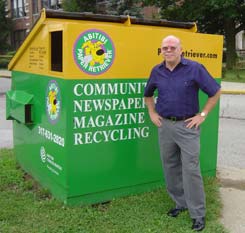NUVO Makes the Switch Without Sacrificing Quality or Cash
Kevin McKinney is a self-described environmentalist. The editor and publisher of NUVO in Indianapolis, McKinney subscribes to the tenets of reduce, reuse, recycle, and pushes for eco-friendly practices at every level. The paper owns its own building, and McKinney is trying to learn how to maintain it in the most ecological fashion. The company buys all recycled products and has timers on lights and computers. In addition, the paper’s staff reuses or recycles just about everything.
NUVO has printed on at least 33 percent recycled newsprint nearly since its inception in 1990, and two months ago, began printing on paper with close to 80 percent recycled content.
A box of factoids on NUVO’s table of contents page lists the resources saved annually by printing on this paper: 6,256 trees, 442,777 gallons of water, 6.4 million BTUs, 1.9 million pounds of greenhouse gases, and 523,384 pounds of solid waste.
What’s not stated there, though, are two salient facts important to publishers and advertisers. “There’s no noticeable difference in photos or art and no change in cost,” says McKinney.
For McKinney, using paper with a higher recycled content is a no-brainer. “We’re trying to make sure NUVO is not leaving a big footprint on the earth,” he says. Recycling and environmental awareness should fit directly with the alternative media’s ethos. “It’s strange that it’s not more part of an alternative weekly’s thinking,” McKinney says.
Of course, trees aren’t completely a dying resource. Paper companies plant tree farms from which they harvest trees to make paper. But consider that 39 percent of all trash in this country comes from paper waste and that newspaper takes up 14 percent of landfill space in this country. Makes recycling seem like a pretty good idea. Being that we’re a country of supply and demand, though, someone has to want your used newsprint in order for recycling to make sense. And what better way to create demand than to print on recycled paper?
Across the country, twelve states and the District of Columbia have laws mandating a “recycled content threshold” that newsprint must meet. Thirteen states, including Indiana, have voluntary thresholds. (In Indiana, recycled paper is defined as having 10 percent post-consumer or post-manufacture material.)
|
Mike Fox — NUVO’s production manager for the past four years and the liaison between the paper and its printer — says this year was the right time to make a move to greater recycled content. “We had gotten all of our processes worked out, so now we could look at more environmentally friendly products.” At HNE Printers in Columbus, Ind., Fox and McKinney also had a like-minded partner when it comes to recycling. The plant, which prints three dailies and 11 weeklies, recycles all its wasted paper and used cardboard paper rolls, says HNE’s general manager, Neil Thompson. That amounts to about 35,000 pounds a week, for which the company receives about $2,000 a month from mills that then turn the waste into recycled paper products.
Because differences in recycled paper can be visible, Fox and McKinney first received a number of paper samples and printed samples to look at. “The higher the recycled content, the more ink from previous papers is in the fibers,” says Fox. “You can actually see it within the fibers. The downside is the paper is not as bright a white because there’s less virgin timber in it.”
The paper must also stay on the press without stretching or tearing and be able to hold ink without running. Paper that’s been recycled a number of times can become weaker, for instance. HNE had found a 100 percent sample, but the paper didn’t work technically. Two of the other samples, though, contained 50 percent and 80 percent recycled content. “The 80 percent didn’t look that much darker so we said, ‘Let’s try it,'” McKinney says.
Trying it required the purchase of a truckload of paper, about enough to print four NUVO issues. The stock arrived early at HNE and, in a miscommunication with the printing staff, someone loaded the paper onto the presses before NUVO had given the okay. NUVO’s paper got printed, and no one noticed anything different. Well, Mike Fox, the production manager saw a difference, but as he says, he’s supposed to notice such things.
To lay people — i.e., readers and advertisers — the difference was nil. “We thought customers might have negative comments, but we got none,” says Fox.
The photos looked just as good. The artwork, too. So for the same cost, NUVO now creates a great product and lives even a little lighter on the earth. Kevin McKinney wonders why all alternative weeklies aren’t seeking out paper with greater recycled content. “I can’t think of a reason why you wouldn’t do it.”
Though NUVO will eventually run an article about its switch to greater recycled content, McKinney wants to hold off for now because he hopes to encourage the chain-owned Indianapolis daily to print on recycled paper, too. “We’re trying to figure out how to put pressure on Gannett without seeming self-righteous,” he says, adding that it’s all right for weeklies to encourage the big dailies — even the chains — to be like them in some regards, especially this one.
Amy Souza is a freelance writer living in Pittsburgh.

